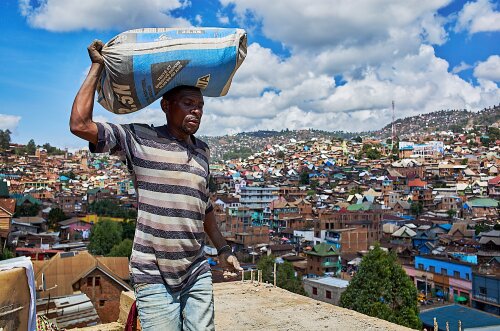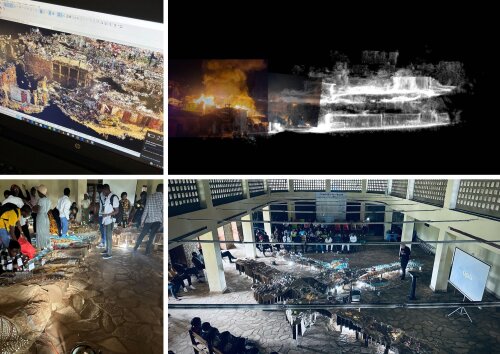From Handmade Gravel to Handmade Urbanism
“From Handmade Gravel to Handmade Urbanism” is a multidisciplinary project, funded by VLIRUOS and bringing together architecture (KULeuven and Université Catholique de Bukavu UCB), environmental sciences (Ecosphere UAntwerpen and UCB) and development studies (Institute of Development Policy UAntwerpen and UCB).
You are welcome to the symposium and opening of two exhibitions
Programme
14:00 — Welcome and Introduction of the VLIR-TEAM Project | Sara Geenen (IOB), Mac Mugumaoderha Cubaka (UCB)
14:15 — In search of Africa's leapfrogging architects | Elien Spillebeen (MO* Magazine)
14:30 — The supply chain of construction materials: 28 pictures & 7 stories | Divin-Luc Bikubanya (IOB), Déborah Muhanzi (UCB), Joseph Bahati Mukulu (IOB)
15:00 — La Grande Maquette | Carl Bourgeois (KU Leuven), Ruben D’hont (Plano Architecten & KU Leuven), Dag Boutsen (KU Leuven)
15:30 — Coffee break
15:45 — Learning from Bukavu | Javier Fernández Contreras, Aida Navarro, Damien Greder (HEAD – Genève, Haute école d’art et de design)
16:15 — Decolonial Approaches | Jeanne Autran-Edorh (Studio NEiDA)
16:30 — Panel discussion moderated by Bossissi Nkuba (IOB) | Charlie Namuyamba (UCB), Divin-Luc Bikubanya (IOB), Judith Lemaire (ULB), Raymond Lutala (UCB), Chandelle Cifende Akonkwa (architecte indépendante)
17:15 — Opening of the exhibition
Exhibition 1. The supply chain of construction materials: 28 pictures & 7 stories
In 2024 photographer Robert Carrubba visually documented the supply chain of sand, stones, gravels, timber, bricks, and cement in and around the city of Bukavu. He did so based on insights from, and together with members of, the VLIR TEAM project From Handmade Gravel to Handmade Urbanism. 9 project members wrote 7 stories accompanying 28 selected pictures. Referring to one stage in the supply chain and an associate practice (breaking, loading, baking, selling, carrying, storing, building), each story showcases the agency of the laborers as well as the risks and the precarity they endure. The pictures and the stories combined shine a light on a sector that is largely invisible in academic research as well as development practice and policies.
The pictures and stories have been published as a chapter in the book Caring for our common home. Sustainability, justice and solidarity within university partnerships (Geenen et al. (Eds.), Owl Press, 2025).

Exhibition 2. Learning from Bukavu: two experimental graphic protocols for humanitarian modelling in an un-planned city
This exhibition will introduce participants to the production of newly sensible graphic methods for designerly urban and architectural research. In the city of Bukavu, Eastern DR Congo, the longstanding internal conflict has blurred the lines between economic mobility towards urbanized centres and the displacement of populations towards safe areas, both phenomena resulting in the rapid growth of cities usually without plans. Unprecedented urban growth and the development challenges of Bukavu are demanding for imaginative debate and original thinking.

Two graphic protocols will be discussed:
Protocol 1 — La Très Grande Maquette (TGM)
In April 2024, around 150 architecture students from the Université Catholique de Bukavu (UCB) built a gigantic model of their city — La Très Grande Maquette (TGM).
This model represents a first attempt to visualize and test pragmatic elements necessary for the city’s expansion. The TGM workshop explored Bukavu’s “implosion and explosion” — scenarios for inclusive and sustainable urban transformation.
Through the TGM, Bukavu’s students and researchers developed a prospective vision addressing challenges such as rapid population growth, high resource consumption, and climate pressures.
Protocol 2 — Humanitarian Design in an Unplanned Neighbourhood
In July 2025, the research group The Future of Humanitarian Design (HUD) co-organized a workshop titled Learning from Bukavu: Humanitarian Design in an Unplanned Neighbourhood.
Participants collected visual data using mobile phones, transforming everyday technology into a “hacking” tool for observation, learning, and reimagining the urban environment.
The workshop produced “sensitive cartographies” — visual narratives that capture Bukavu’s development challenges and potential. Starting from the small scale and from within the community, these graphic explorations seek to reappropriate mapping as a design tool, enabling alternative and locally grounded planning proposals.